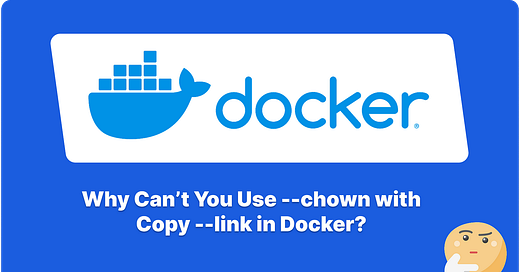Why Can’t You Use --chown with Copy --link in Docker?
Understanding the Incompatibility Between --chown and --link in Docker COPY Operations
Why Can’t You Use --chown with Copy --link in Docker?
In Docker, the --link flag was introduced to optimize image builds by creating deterministic, content-only layers. It focuses strictly on file content, not ownership or system state.
🔗 Official Docker Docs: --link
For an in-depth look at the pros and cons of COPY --link in Docker, check out my dedicated deep dive:
So, what happens when you try to combine it with --chown?
Because --link runs the copy operation in an isolated layer, it doesn't have access to user databases like /etc/passwd from the base image. When you try:
COPY --link --chown=nginx:nginx ./my-content /usr/share/nginx/htmlDocker will throw:
invalid user index: -1It can’t find nginx because that user doesn’t exist in the isolated layer created by --link.
Best Practice: Use COPY --link with USER, Not --chown
When building Docker images, the cleanest and most efficient way to manage file permissions is to use COPY --link without --chown, and let the USER instruction handle access control. The --link flag ensures deterministic, content-only layers that are fast, cacheable, and reproducible. Adding --chown breaks this by requiring access to user metadata (e.g. /etc/passwd), which isn’t available in the isolated copy layer — causing build failures like invalid user index: -1.
Instead, structure your Dockerfile like this:
FROM nginx:stable
# Use content-only copy
COPY --link ./my-content /usr/share/nginx/html
# Set the user to run the container process
USER nginx
EXPOSE 8080
CMD ["nginx", "-g", "daemon off;"]This way:
Your build stays fast and deterministic.
The
nginxuser runs the process and can read the files.You avoid unnecessary
chownoperations, which are often not needed for static assets.
If write access is required (rare for static content), skip --link and handle ownership explicitly using a RUN chown or runtime script — but only when necessary.
Keep it clean. Let Docker do what it’s good at.
❤️ If you like my work, please follow me and subscribe ❤️
Front-end World is a reader-supported publication. To receive new posts and support my work, consider becoming a free or paid subscriber.






